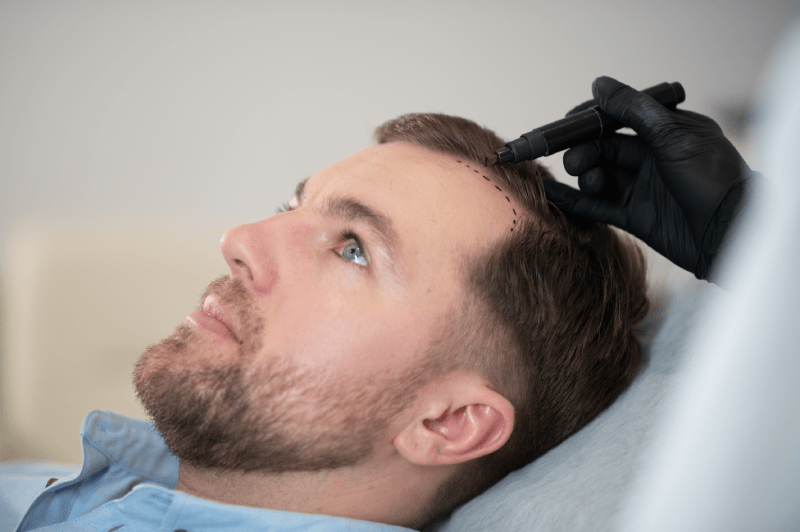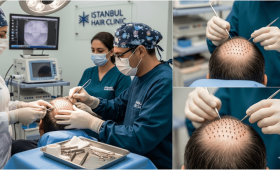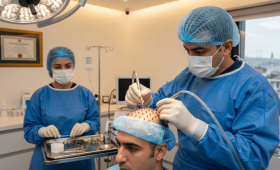What Exactly Is Hair Transplantation And How Is It Performed?
Hair transplantation is a surgical procedure that involves the process of transplanting hair follicles to areas experiencing thinning or baldness. Follicular units are individually harvested from donor areas, typically the back of the head, which are genetically resistant to shedding. These follicles are then meticulously placed into the determined recipient area, taking into account the person’s natural hair growth direction and density. The procedure is mostly performed under local anesthesia, and the success of the application depends on preserving the viability of the follicles and implanting them at the correct angle. The operation duration varies depending on the number of grafts to be transplanted and usually lasts a full day.
What Kind Of Procedure Is The FUE Technique And What Are Its Advantages?
The Follicular Unit Extraction (FUE) technique is a modern method where hair follicles are extracted individually from the donor area using special micromotors or manual punch tools. This method is much less invasive than the traditional FUT method, and its biggest advantage is that it does not leave a linear scar requiring stitches in the donor area. Only millimetric small holes are formed, which heal quickly and become almost invisible. FUE is the most preferred method today due to its quick recovery time, less pain, and the comfort it offers to the patient, making it a highly desirable option for many individuals seeking hair restoration.
How Does The FUT Method Differ From FUE?
Follicular Unit Transplantation (FUT), unlike FUE, is based on the surgical removal of a thin strip of skin containing hair follicles from the donor area. This strip is then carefully dissected under a microscope and prepared for transplantation. The most distinct difference of FUT is that it leaves a permanent linear scar requiring stitches where the strip was taken. This method can allow for a higher number of grafts to be harvested in a single session, but the recovery process can be longer and more painful compared to FUE. However, the FUE technique has significantly increased in popularity in recent years, making it the dominant method globally.
Is DHI Hair Transplantation Different From Others?
The Direct Hair Implantation (DHI) technique is essentially a variation of the FUE method, where a special Choi pen is used to directly implant the hair follicles into the recipient area, bypassing the step of creating incisions (channels) after graft collection. The main difference of this pen is that it performs both the micro-channel opening and the root placement in a single motion. DHI allows for denser and more controlled transplantation in the recipient area, often without completely shaving the hair. As a result, the recovery process can be faster, and the risk of damage to existing hair is reduced.
Is The Hair Transplant Procedure A Permanent Solution?
Yes, the results of the hair transplant procedure are generally permanent for life. The main reason for this is that the hair follicles used for transplantation (usually taken from the back or sides of the head) are genetically resistant to the DHT hormone. These follicles retain their resistance to shedding even when transplanted to their new location and tend to continue growing throughout life. A successful operation, combined with proper care, provides a long-term and effective solution to the person’s baldness problem, even if the natural hair loss pattern continues.
Will I Feel Pain During The Procedure?
Since the hair transplant procedure is performed under local anesthesia, patients usually do not feel any pain or discomfort during the operation. A slight stinging sensation may occur during the application of the anesthesia, but this is very brief. Once the anesthesia takes effect, the patient is fully awake and comfortable throughout the operation; they can even read a book or watch a movie. There may be mild tension or sensitivity in the first few days after the procedure, but this condition is usually controlled with simple painkillers and subsides quickly.
How Long Does The Operation Take?
The duration of the hair transplant operation varies depending primarily on the number of grafts to be transplanted and the technique applied. Transplantations done for a small area can take 4-5 hours, while procedures for a large bald area requiring a high number of grafts can take between 6 to 9 hours. Most operations take a full day, with short breaks and a lunch break provided for the patient’s comfort. This long duration is necessary for the careful and meticulous placement of each hair follicle at the correct angle to ensure optimal results.
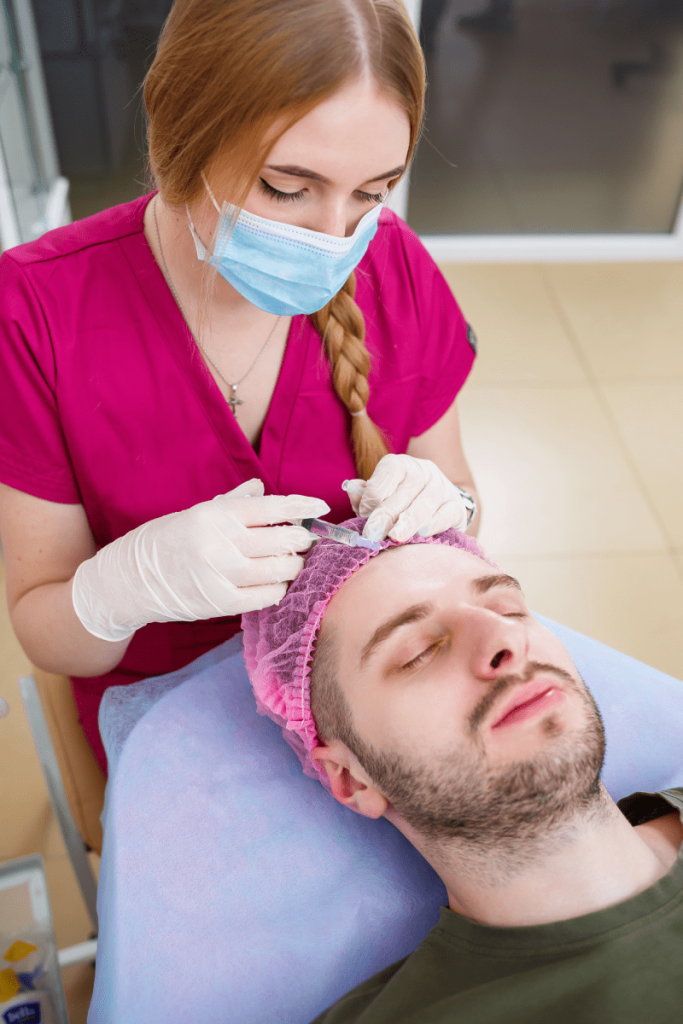
How Do I Know If I Am A Suitable Candidate For Hair Transplantation?
To determine if you are a suitable candidate, the cause, type, and stage of your hair loss are primarily evaluated. Having a sufficient and healthy donor area is the most important criterion. Additionally, you should be in good general health, not have any chronic illnesses, and have realistic expectations for the hair transplant outcome. For individuals under the age of 20, waiting is usually recommended as the hair loss pattern has not yet stabilized. The final assessment is made based on hair analysis and one-on-one consultation with a specialist.
Why Is The Donor Area So Important?
The donor area, typically the back and sides of the head, is vital for the success and sustainability of the hair transplant. The density and quality of the hair follicles in this area determine the maximum number of grafts that can be transplanted during the procedure. If the hair in the donor area is sparse or weak, the desired density may not be achieved in the transplanted area. Furthermore, the DHT-resistant nature of the follicles taken from the donor area is the key factor that guarantees the permanence of the transplanted hair. Proper management of the donor area is also critical for potential future sessions.
Can Only Men Get Hair Transplants?
No, hair transplantation is not an exclusive procedure for men; women can also have hair transplants. Although hair loss in women is usually seen in different patterns than in men (diffuse thinning), hair transplantation offers an excellent solution for women who have a suitable donor area and whose hair loss is diagnosed as permanent. Successful results are achieved, especially for receding hairlines or specific thinning in the crown area. DHI and other non-shaven or partially shaven techniques are also frequently preferred for female patients.
Must Hair Loss Have Completely Stopped?
Ideally, the person undergoing a hair transplant is expected to have largely stabilized hair loss. Performing a transplant while hair loss is still progressing, especially at a young age, can lead to the formation of new bald patches behind the transplanted hair as existing hairs continue to shed. This situation necessitates another session in the future. Therefore, the period after age 25, when shedding has slowed or formed a specific pattern, is generally considered more suitable. This condition is examined in detail during consultation.
What Is The Ideal Age Range For Hair Transplantation?
While there is no strict age limit for hair transplantation, most specialists consider individuals between 25 and 65 years old to be the most suitable candidates. In transplants performed before age 25, the risk of facing new hair loss in the future is high because the hair loss pattern has not fully stabilized. In patients over 65, general health status and the quality of hair in the donor area must be assessed more carefully. Having sufficient density in the donor area and the patient having realistic expectations are more important than the age factor itself.
What Is The Maximum Number Of Grafts That Can Be Transplanted In One Session?
The maximum number of grafts that can be transplanted in one session depends primarily on the patient’s hair density and elasticity in the donor area. On average, between 2500 and 4500 grafts can be transplanted in one session, but this number varies greatly from person to person. Overuse of the donor area can cause permanent damage, such as thinning or sparseness, in that region. Therefore, it is critically important for specialists to determine a reasonable graft count by preserving the donor area for a successful and natural result.
How Is Hairline Design Done?
The most crucial element for a natural and successful hair transplant result is the personalized hairline design. This design is created considering the patient’s face shape, forehead muscle structure, age, and potential future hair loss pattern. To achieve a natural appearance, the hairline should be symmetrical, the corners should suit the face, and it should contain micro-irregularities instead of a completely straight line. Experienced teams determine the most aesthetic and natural-looking line together with the patient, taking their wishes into account during the process.
How Long Is The Recovery Process And When Can I Return To Work?
The recovery process after a hair transplant is usually quite fast. The first 10 to 14 days are critical for the scabs in the recipient area to fall off and the area to heal completely. Most patients can return to desk jobs or light social activities within 3 to 7 days. However, during this period, it is essential to avoid strenuous physical activities and sports that cause sweating, as these could harm the transplanted grafts. Full recovery and return to normal social life are largely completed by the end of two weeks.
When Do The Transplanted Hairs First Fall Out And Is This Normal?
Yes, the temporary shedding of transplanted hairs about 2 to 6 weeks after the procedure is a completely normal and expected condition. This is called “shock loss” and indicates that the transplanted hair follicles have entered the resting (telogen) phase. The hair roots remain beneath the skin and start to produce new and healthy hair permanently after 2-4 months. Although this stage is worrying for many patients, it is a sign that the procedure was successful and that the new growth cycle has begun, so there is no need to panic.
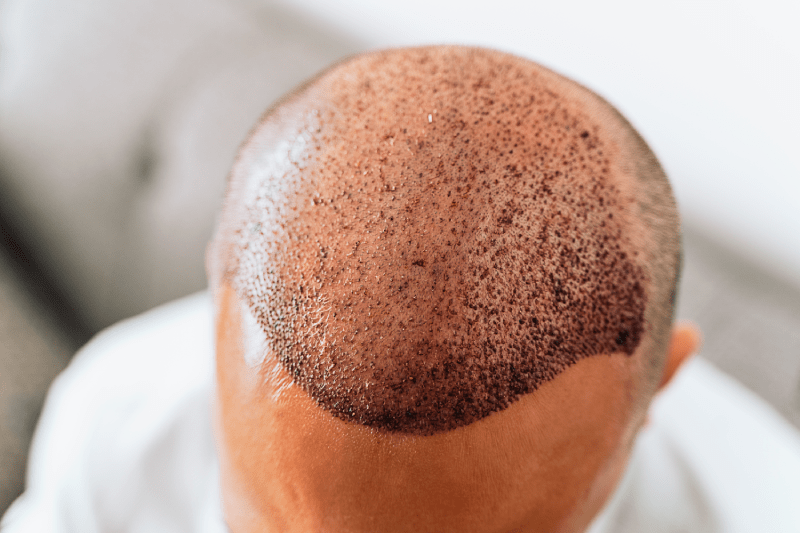
How Long Does It Take To See The Final Results?
Seeing the full results of a hair transplant is a process that requires patience. After the initial shedding phase, the hair slowly begins to grow. The first noticeable growth is observed from the 4th month onwards. Hair density and quality increase rapidly between 6 and 8 months. However, it usually takes 12 to 18 months for the transplanted hair to fully thicken, mature, and reach its final density. During this period, the hair completes its natural cycle and achieves its best appearance.
Will There Be Swelling And Redness During The Recovery Period?
Yes, experiencing mild to moderate swelling (edema) and redness in both the donor and recipient areas is quite common, especially in the first few days after the operation. Swelling usually starts from the forehead and may travel down to the eye area but disappears on its own within 3 to 5 days. Redness, while varying from person to person, can last a few weeks or sometimes a few months on sensitive skin. Medications recommended by specialists and the application of cold compresses help keep swelling to a minimum.
How Should The First Wash Be Performed After Hair Transplantation?
The first wash after a hair transplant should usually be performed 48 to 72 hours after the operation and only exactly as specified by the specialists. This wash is typically carried out by the expert center itself using a gentle and delicate method. When patients perform subsequent washes, it is important to absolutely avoid touching the transplanted grafts and use low-pressure water. The special lotion and shampoos provided help soften and gently remove the scabs, preventing the grafts from shifting.
Do Transplanted Hairs Provide A Natural Look?
Thanks to modern hair transplant techniques and the experience of expert teams, the transplanted hair provides an extremely natural appearance. The key to naturalness is the individual placement of grafts at the appropriate angle and direction of the person’s existing hair growth. In a successful transplant, the hairline has a natural asymmetry, and density transitions are made gradually. This meticulous placement process ensures that the hair, once fully grown, looks so original that no one can tell the difference.
When Can I Blow Dry Or Style My New Hair?
You generally need to be patient for the first three months before you can blow dry or style your newly transplanted hair. The first month is the most critical period for the grafts to fully take root and heal. Extra mechanical stress such as heat, chemicals, or brushing can damage the roots. Generally, after 6 months, as the hair has strengthened and grown sufficiently, you can start blow drying on a low heat setting or use light styling products.
When Can I Start Exercising After Hair Transplantation?
Strenuous sports and intense physical activities increase body temperature and blood pressure, causing sweating. Sweat can pose an infection risk for the healing grafts and soften the scabs. Therefore, all intense sports, weight lifting, and cardio, other than light activities like brisk walking, must be strictly avoided for the first 10 days. Generally, after two weeks, most patients can return to their normal exercise routines under controlled conditions.
How Should I Protect Myself From The Sun And Rain?
Transplanted hair follicles are highly sensitive to the sun’s harmful UV rays during the recovery period. Sunburn can permanently damage the grafts and cause discoloration in the transplanted area. Therefore, direct sun exposure should be avoided for the first month after the operation. In rainy weather, a hat or hood should be used to prevent water droplets from contacting the grafts. High-factor sunscreen is recommended after the third month for prolonged sun exposure.
When Can I Start Wearing A Hat?
The time you should wait to wear a hat depends on the type of hat and the transplantation technique. Everything that contacts the recipient area should be avoided for the first 5 to 7 days to prevent the grafts from dislodging. Generally, after the 10th day, you can start wearing a wide and loose hat (like a bucket hat) that does not put pressure on the transplanted area. Absolutely no tight headwear like beanies or helmets should be used during the first month, as this poses a high risk of damage to the roots.
Is Alcohol And Smoking Harmful After Hair Transplantation?
Yes, alcohol and smoking before and after a hair transplant negatively affect the healing process and final results. Alcohol increases the risk of bleeding during and after the operation due to its blood-thinning effect. Smoking, due to the nicotine and carbon monoxide it contains, severely restricts blood flow to the scalp, which makes it difficult for the transplanted grafts to receive oxygen and nutrients and lowers the survival rate. Specialists strongly recommend abstaining from these substances for at least one week before and two weeks after the operation.
When Can I Shave My Transplanted Hair?
The time to shave the transplanted hair with clippers or a razor depends on the completion of healing. Generally, the hair in the donor area can be trimmed with scissors after the first month. However, to apply a razor or electric shaver to the transplanted area, you should wait for the roots to fully strengthen and settle, making this period recommended as at least 6 months or preferably one year. Early shaving risks damaging the roots or delaying the thickening of the new hair.
Are Special Shampoos Necessary For Post-Transplant Hair Care?
Yes, special shampoos and lotions are almost always recommended for the first few weeks after hair transplantation to support healing and avoid damaging the sensitive grafts. These products typically have pH-balanced, alcohol-free, and non-chemical formulas. Even after the critical initial period, using anti-hair loss or biotin-containing shampoos as advised by the specialist can be beneficial in the long term to nourish the transplanted hair follicles and maintain scalp health.
How Long Should I Wait Before Having Sexual Intercourse?
The waiting period for sexual intercourse after a hair transplant is important to minimize the risks of sweating, increased blood pressure, and pressure on the scalp that may occur during activity. Specialists generally recommend abstaining from sexual activity for the first 5 to 7 days. This period is the first critical time frame when the transplanted grafts begin to adhere firmly to the scalp. After this period, you can return to normal life, provided you are careful not to damage the scalp.
How Much Does A Hair Transplant Cost In The United Kingdom?
Hair transplant costs in the United Kingdom vary significantly depending on the quality of service, the number of grafts to be transplanted, and the preferred technique. Prices are usually much higher than in countries like Turkey, starting from 4,000 GBP and potentially reaching up to 15,000 GBP or more. This high cost is one of the reasons why many patients research and prefer international centers, especially Turkey, which offer equally high-quality service at a more affordable price. It is important to get detailed information about the transparency of the cost.
Why Are Other Countries Preferred Despite The High Costs?
The high costs in the United Kingdom lead many patients to choose centers abroad for their hair transplant. Countries like Turkey, prominent in health tourism, offer package services with experienced teams and state-of-the-art equipment at a much lower cost than UK prices. These packages often include additional services such as accommodation, transfers, and post-operative care. Patients turn to international health tourism by evaluating these options to save money without sacrificing quality.
Is Hair Transplantation Guaranteed And What If It Fails?
Although no surgical procedure can guarantee 100% success, the graft survival rate in a successful hair transplant is usually above 90%. In case of failure (very low adherence or unnatural appearance), the cause of the problem should be examined in detail. Reputable centers typically offer a free corrective session or graft replacement under the conditions specified in their contracts (e.g., if grafts do not take root through no fault of the patient). Choosing the right center is essential to minimize the risk of failure.
Can More Than One Hair Transplant Session Be Necessary?
Yes, in some cases, more than one hair transplant session may be necessary to achieve the maximum density requested by the patient or to cover ongoing hair loss in later years. Especially in patients experiencing advanced baldness on the Norwood scale or those with limited donor capacity, dividing the transplantation process into two or more sessions yields the best result. Since the donor area must fully heal for a second session, a period of at least 8 to 12 months should generally be allowed between these sessions.
What Type Of Anesthesia Is Used During The Hair Transplant Procedure?
Hair transplant operations are generally performed under local anesthesia to ensure patient comfort and safety. Local anesthesia numbs only the scalp and allows the patient to remain awake and conscious throughout the procedure. In recent years, the use of needle-free injection systems (pressurized jet injection) for anesthesia has also gained popularity to minimize pain. In rare cases, upon the patient’s request and with specialist approval, light sedation may be added for further relaxation.
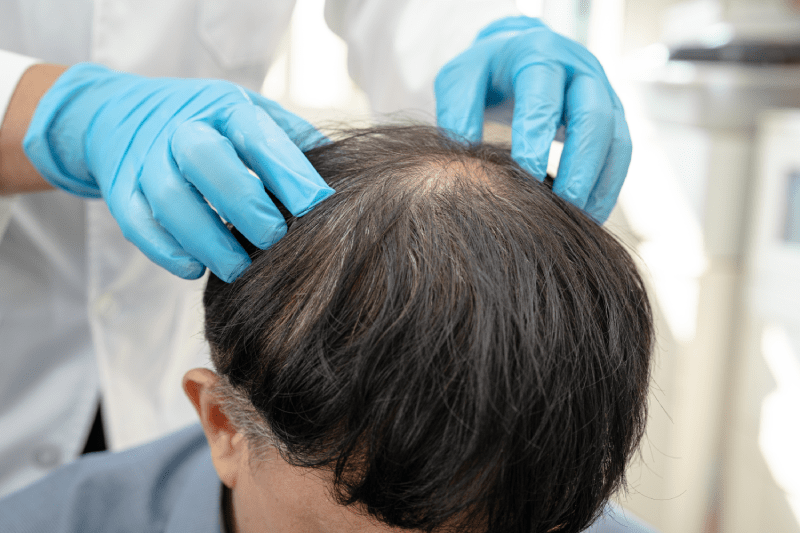
What Medications Or Supplements Are Recommended After Hair Transplantation?
Certain medications and supplements may be recommended after a hair transplant to support healing and slow the shedding of existing hair. These generally include painkillers, antibiotics (to prevent infection), and anti-edema medications. In the long term, topical solutions like Minoxidil or oral medications like Finasteride (with specialist consultation) may be used to strengthen existing, non-transplanted hair. Additionally, vitamin supplements that support hair health, such as biotin and zinc, may also be recommended.
Is It Safe To Have A Hair Transplant Abroad?
Having a hair transplant abroad can be extremely safe, provided you choose the right center and team. Countries prominent in health tourism, such as Turkey, offer high-standard facilities and experienced teams with international accreditations. Safety primarily depends on the hygiene of the clinic you choose, the quality of the equipment used, and the expertise of the specialized personnel. Conducting detailed research, checking reviews, and establishing transparent communication are the keys to making this process safe.
Can Beard Or Moustache Transplantation Be Done Along With Hair Transplantation?
Yes, beard or moustache transplantation can be performed along with a hair transplant in the same session or in different sessions. The FUE technique is also used in principle for beard and moustache transplantation, and hair follicles are generally taken from the back donor area of the head. This combination is particularly preferred by patients seeking comprehensive cosmetic changes. However, since the total number of grafts that can be taken from the donor area is limited, specialists must carefully plan the most suitable graft distribution between the hair, beard, and moustache.
What Kind Of Preparations Should Be Made Before The Hair Transplant Procedure?
The preparation process before a hair transplant directly affects the success of the operation. At least one week before the procedure, blood thinners (aspirin, etc.), Vitamin E, alcohol, and smoking must be stopped. Comfortable clothing should be preferred on the day of the operation, and caffeinated drinks should be avoided. Furthermore, having a clean scalp and using special shampoos recommended by the specialist will be beneficial. All these preparations help reduce the risk of bleeding and optimize the effect of the anesthesia.
What Should The Sleeping Position Be During The Recovery Period?
The sleeping position during the recovery process is critically important. To absolutely avoid contact with the transplanted grafts for the first 7 to 10 days after the operation, it is essential to sleep on your back and in an elevated position. Keeping the head elevated at a 45-degree angle also helps reduce swelling and edema. Neck pillows or extra pillows can be used for this purpose. Lying on your stomach or side can cause the newly transplanted follicles to shift or become damaged.
When Do The Scabs Formed After Hair Transplantation Fall Off?
The small, brownish scabs formed after a hair transplant are a natural part of the healing process and consist of clotted blood around the transplanted follicles. These scabs generally begin to fall off gradually between 7 and 10 days after the operation, thanks to special washes and massages performed according to the specialist’s instructions. Forcefully scratching or picking the scabs is strictly not recommended, as this could lead to the permanent loss of the transplanted grafts.
Will My Existing Hair Fall Out After Hair Transplantation?
Apart from the temporary shedding of the transplanted hair (shock loss), temporary shedding of existing hair is also rarely observed after a hair transplant. This condition occurs due to the physical stress or trauma caused by the operation and is generally not permanent. The existing hair returns to its normal growth cycle after a few months. To reduce this risk and strengthen existing hair, anti-hair loss medications and vitamin supplements recommended by specialists can be used.
Can Hair Follicles Be Taken From Another Body Part?
Yes, in cases where the hair density in the donor area is insufficient, hair follicles can be taken from body areas such as the chest, back, or under the beard (Body Hair Transplant – BHT). However, since body hairs have a different growth cycle, thickness, and length compared to scalp hair, these follicles are generally used only as a supportive measure for increasing density. The sub-beard area is generally the most preferred body donor site as it has the closest quality to scalp hair.
What If The Hair Transplant Result Is Different Than Expected?
If the hair transplant result does not align with the patient’s realistic initial expectations or if an aesthetic problem occurs, a correction (touch-up) session is usually planned. This typically happens at least one year after the initial operation, as the final results must fully emerge. Correction sessions involve small-scale transplants to fix minor hairline errors, add density to sparse areas, or enhance naturalness. Working with a specialized and experienced team is essential for a successful correction.
What Should Be Done If Itching Occurs During The Recovery Process?
It is quite common to experience mild itching during the recovery process, especially when the scabs begin to fall off, and this is a sign that the scalp is healing. However, scratching or rubbing the itchy area with nails should be strictly avoided as it can damage the transplanted grafts. Specialists usually recommend special moisturizing lotions, sprays, or prescription antihistamines to help reduce itching. Applying these products gently will help relieve the discomfort.
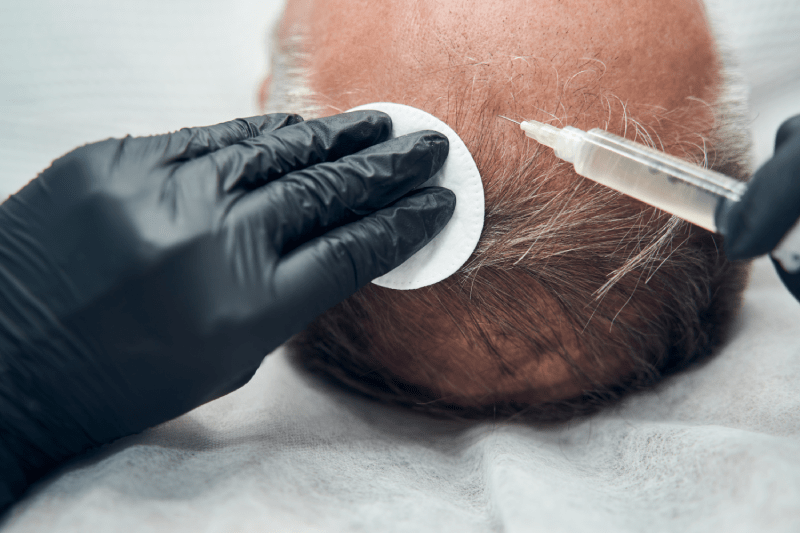
What Should The Skincare Routine Be After Hair Transplantation?
The skincare routine for the first few weeks after a hair transplant must be minimalist and gentle. After following the instructions for the first wash, only products specifically recommended for the scalp should be used. Care should be taken not to touch the transplanted area during daily routines like face washing and shaving. Harsh chemical makeup or skincare products should be avoided, especially during the first two weeks. Sun protection and sprays that keep the scalp moisturized are an important part of the routine during this period.
Is It Safe To Travel After The Hair Transplant Procedure?
It is generally safe to travel immediately after a hair transplant procedure, but some precautions must be taken. Patients traveling by air are advised to keep their heads elevated and drink plenty of fluids to minimize the effects of cabin pressure changes. Additionally, using a comfortable neck pillow to avoid pressure on the transplanted area is important. While resting for the first 24 hours after the operation is ideal, most patients can generally travel safely the next day.
Is High Blood Pressure A Barrier To Hair Transplantation?
Controlled and regularly monitored high blood pressure (hypertension) usually does not pose a barrier to the hair transplant procedure. However, a sudden increase in blood pressure during the operation can increase the risk of bleeding and negatively affect the success of the procedure. Therefore, the patient must ensure their blood pressure values are within normal limits before the operation. Specialists will provide the patient with detailed information about the dosage and timing of blood pressure medications.
When Should Medications Against Hair Loss Be Started?
The use of medications for hair loss, such as topical Minoxidil or oral Finasteride, must be carefully planned with a specialist’s advice before and after the hair transplant procedure. Generally, these medications are recommended to be stopped one week before the operation and not used for the first 2 to 4 weeks to avoid harming the transplanted grafts. After the recovery period, the decision to continue the medication to protect and strengthen existing hair is made by the specialists according to the individual’s situation.
Will The Transplanted Hair Turn Gray Or White Later On?
Yes, just like other hair in the donor area, the transplanted hair will turn gray or white with age. This is because the transplanted follicles are genetically native to the donor area and retain their cycle of stopping melanin production. Hair transplantation does not change hair color or the aging process; it only moves resistant follicles to the bald area. Therefore, the transplanted hair will change color in accordance with the person’s natural aging process.
Is Massaging Beneficial After Hair Transplantation?
Massaging after a hair transplant can be beneficial for both areas at different times and for different purposes. The donor area can be lightly massaged after healing accelerates to increase blood circulation and restore elasticity. However, the recipient area should be massaged with very gentle and light movements after the scabs fall off (usually after the 10th day), as this helps both the scabs to shed and supports hair growth by increasing blood circulation. Absolutely no pressure should be applied to the transplanted area during the first ten days.
